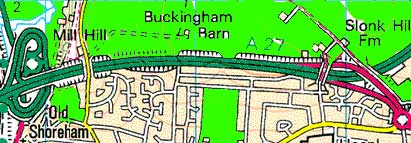 Slonk
Hill Cutting: A27
Embankment
Slonk
Hill Cutting: A27
Embankment
 Slonk
Hill Cutting: A27
Embankment
Slonk
Hill Cutting: A27
Embankment
 |
The footpath runs parallel with the main road through the spinney (linear wood) on the southern side, immediately north of Slonk Hill Farm Road. There are several access points, notably at the top of The Drive (in the west) and by the bridge over the road to Slonk Hill Farm (in the east). Reports of the Dovecote Bank (from Mill Hill bridge to the top of The Drive) included this year. There are no practical access points to the steep northern bank. |
 |
9 October
2005
A
dark Common Lizard
was seen on a wooden pallet next to where the Water
Shrew was seen before. This lizard was not
quite fully grown.
2
October 2005
There
was a shrew seen
underneath a large piece of boarding of south of the path on the southern
bank of the Slonk Hill Cutting where it winds its way through vegetation
at the western end. I am not familiar with shrews:
this one was 50% larger than a House Mouse
and it had a white rim that appeared like the edge of a skirt around its
dark grey-black furry coat. It moved to and fro about five seconds before
disappearing. I have tentatively identified this as a Water
Shrew, Neomys
fodiens. This
is a partially protected species. It is found in area where Slow
Worms have been discovered before.
Mammal
Society Factsheet on the Water Shrew
A
minute later, there were two juvenile Common
Lizards on an ant hill and they disappeared
after about five seconds as well. These lizards were a dark brown in colour.
Overhead there was a small flock of Rooks
that flew into view above trees for about ten seconds.
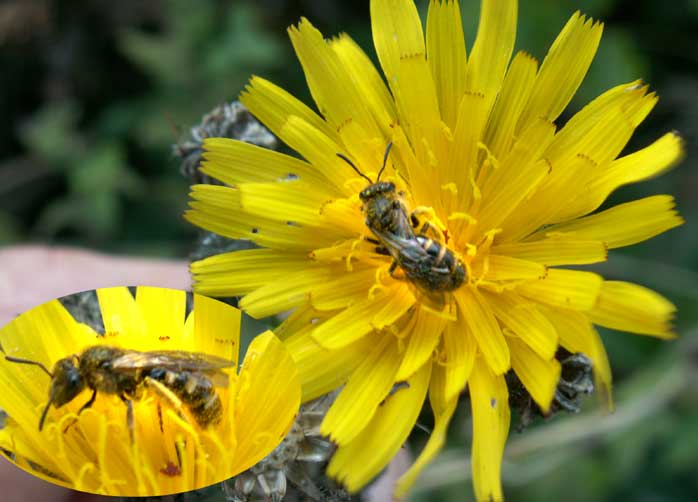 |
This is probably a species of Lasioglossum, most likely Lasioglossum calceatum. ID to genus confirmed and to species suggested by Philippe Moniotte on the British Insects (Yahoo Group) |
 |
18
September 2005
As
we drove through the Slonk Hill Cutting on the A27
at Shoreham a large flock of Starlings
where swooping in tight formation at about 15 metres high to the left of
the road. Among them an fast moving bird of
prey was flying among them seeking out a target.
As we passed we saw it take one of the birds with its talons in mid air.
I think the raptor had a fairly long tail and was slightly larger than
the Starlings maybe about pigeon size. It was possibly the local Peregrine?
A
Slow
Worm was recorded under a wooden pallet
on the southern side overgrown*
path. Acorns on a shrub-sized Oak Tree were spotted, the tree dwarfed
and shaded by the Sycamore
next to it. (*Difficult passage with covered
arms and secateurs advised.)
28
August 2005
At
least one yellow
Orb Spider, Araneus quadratus,
was
feeding on a grasshopper and the webs of
Araneus
species (the two common species were not differentiated) were frequent.
There was a Kidney Vetch
still in flower.
Picture
Report
Adur
Spiders
 21
August 2005
21
August 2005
A
Common
Lizard skittered across an ant's mound.
A Garden Orb Spider,
Araneus
diadematus,
caught a bee or hoverfly
almost its own size in its web. At least a dozen male Common
Blue Butterflies were around, and about
half of them were bluish females. The Marmalade
Fly (hoverfly), Episyrphus
balteatus, was frequently seen.
Other butterflies were at least two Speckled
Woods, one Red
Admiral, one Holly
Blue, and a Wall
Brown Butterfly at the top of The Drive
on the road and it flew into the wall of a house was almost confirmed as
a definite, but it flew away too rapidly for a close look. The small green
damselfly was a Common Blue Damselfly female.
Butterfly
List for the Day
Adur
Spiders
18
August 2005
 |
 |
The
first Wasp Spider
seen this year was a smallish one that had captured a Meadow Grasshopper
on the Slonk Hill Cutting and had rolled it up in its webbing.
Adur
Spiders
Adur
Grasshoppers
14
August 2005
The
part of the Slonk Hill Cutting at the top of The Drive and the hedgerows
to the east, produced at least one Gatekeeper
Butterfly, a few Meadow
Browns, and in the hedgerows the first
standard coloured Speckled Wood Butterfly,
followed by a darker one. The flitting brown was a Yellow
Shell Moth. At least a dozen male Common
Blue Butterflies were disturbed from the
long grass further to the east. After a rain deluge and overcast sky with
a distinctive breeze, made conditions relatively poor for butterflies.
One Common Blue Damselfly
was noted and one Syrphus hoverfly.
2 August
2005
Sunny,
warm and exceptionally humid (about 70% at
22.2° C), but it showed promise for butterflies
and other flying insects: a Red Admiral
was the first butterfly seen, followed by frequent Meadow
Browns (no Ringlets
were seen), two Small Blues,
a handful of Common Blues
including bluish females, at least two Holly
Blues, occasional Large
Whites, at least two Small
(or Essex) Skippers (some looked like
Large Skippers, but closer inspection revealed all as Small Skippers),
a
handful of Speckled Woods and
a confirmed Green-veined White,
which may have been one of several. The tenth species to be recorded was
a Gatekeeper.
Butterfly
List for the Day
There
were at least two and probably many more Common
Darter Dragonflies, all with yellow abdomens.
The blue green algae (Cyanobacteria)
known as Nostoc
commune was swelling up on the
road bank after the recent rain.
Adur
Dragonflies
31
July 2005
As
I left home, I felt the first spots of rain under an overcast sky. On Slonk
Hill, the sun pierced the cloud cover for five minutes and the butterfly
count included 20+ Meadow Brown
Butterflies, 6+ Gatekeepers
and
at least one Ringlet Butterfly
on the southern road embankment. Adjacent to the path there were about
a dozen Common
Blue
Butterflies
with both males and the brown females (they look similar to Brown
Argus Butterflies), a handful each of Large
White Butterflies, Meadow
Browns and Gatekeepers,
and just the one Small (or Essex) Skipper,
one Holly Blue
and one Green-veined White actually
seen. A Yellow Shell Moth
was disturbed.
Butterfly
List for the Day
 |
 |
 |
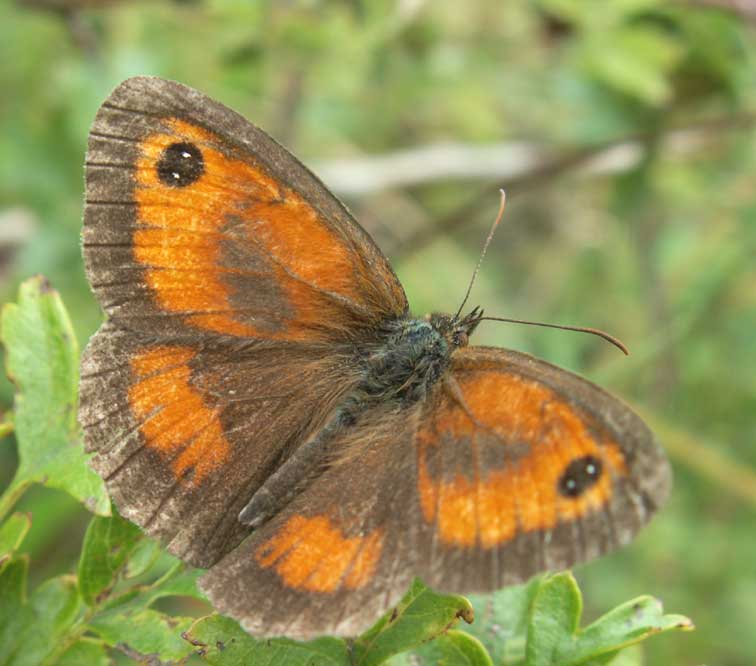 |
There was also a handful of Common Darter Dragonflies amongst the Salad Burnet and roadside herbs. A 14-spot Ladybird, Propylea quattuordecimpunctata, landed on my hand. The number of flying insects on the path was high enough to be irritating. The path was overgrown and passage by bicycle required walking.
22
July 2005
By
11:00
am the sky had become grey and overcast after
a bright sunny start to the morning.
Butterflies
present on my passage visit and seen by me were Gatekeepers,
Large
Whites,
Green-veined
Whites,
Meadow
Browns,
Small
(or Essex) Skippers,
Small
Blues, a
handful of Common Blues,
a Speckled Wood
and a Red Admiral:
a total of nine species.
Butterfly
List for the Day
 |
 |
 |
 |
Hoverflies
were mating and there were at least five different species of the usual
ones. There appeared to be some young amongst the Slow
Worms under a discarded mattress. Fleabane
was beginning to flower. A Common Blue
Damselfly flitted through the tall grasses,
and a small-to-medium-sized dragonfly was spotted
higher in the trees. Both the Common Field
Grasshopper, Chorthippus brunneus,
and the Meadow Grasshopper, Chorthippus parallelus, were
common enough to get photographs. The first species was in the gravely
meadow area including the Cotoneaster and the latter in the long grasses
next to the overgrown path. Spiders
included at least one Garden Orb,
Araneus
diadematus, and the tunnel nests of Agelena
labyrinthica.
Adur
Grasshoppers
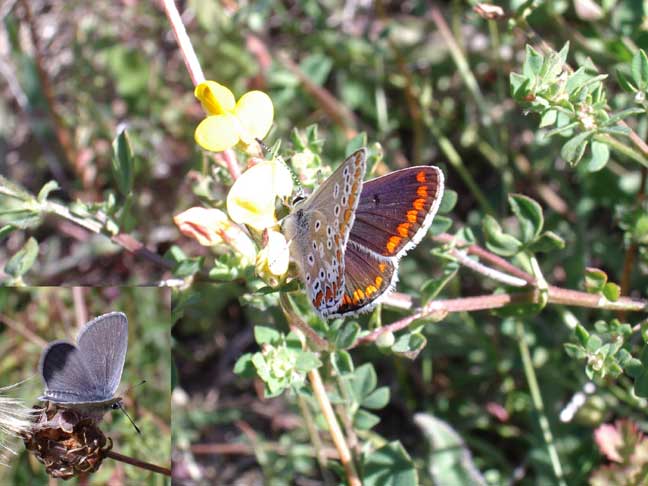
17
July 2005
Butterflies
were common (about 400 in an hour*)
but at least half of them were skippers which
appear a bit like moths to the casual rambler.
Fifteen
species of butterfly and skipper were
seen on the Slonk Hill Cutting (southern bank) which is the largest variety
of species seen in a single day this year so far. I was pleased to note
Ringlet
Butterflies,
Brown
Argus and
at least ten Small Blues.
Of the numerous (40+) Six-spot Burnet Moths,
a pair were observed on a Pyramidal Orchid
which seem to be flowering later than usual this year. (*I
spent 55 minutes on a delayed passage journey and my viewing total was
estimated at 350 to 400.)
Adur
Moths
Butterfly
List for the Day
 |
 |
 |
 |
 |
10
July 2005
As
the temperature hit 27.2° C, I ambled
it very slowly along the partially overgrown (the hedges had been cut back)
path and bank. The Slonk Hill Cutting produced 23+ (counted) Small/Essex
Skippers, but no Large
Skippers, a partly counted and estimated 45+
Meadow
Brown Butterflies, and partly counted
and estimated 44+ Gatekeepers,
5+ whites, probably all Green-veined Whites
(as one was confirmed). a count of 7+ Marbled
Whites, plus an estimated 10+ Ringlet
Butterflies. Alas,
the Comma variant hutchinsoni
of yesterday failed to show.
 |
 |
 |
|
|
|
ID by Stuart Dunlop (Donegal) |
There
was at least 15, probably many more 6-spotted
Burnet Moths. Species of hoverfly
were collectively common, about 80 Episyrphus
balteatus and
at least a dozen Myathropa florea
and more than half a dozen of at least one other species.
There
was a small black and yellow hoverfly Chrysotoxum
bicinctum. It looked very much like a
Conop
fly.
8 July
2005
The
brown butterflies thought to be Meadow Browns
yesterday all turned out to be Ringlet
Butterflies. They behaved the same way
today flying up after hiding in the grass, but this time I was able to
catch up with them to confirm most of them were Ringlets,
although there were a handful of Meadow
Browns as well.
 Five
Small/Essex
Skippers and three Marbled
Whites, two Commas
and one probable Green-veined White
(looking like a Large White)
were present as well. One of the Comma Butterflieslooked
so odd it was almost aberrant and appeared to be much duller, and had smaller,
lesser number of black spots and markings than on all the others.
Five
Small/Essex
Skippers and three Marbled
Whites, two Commas
and one probable Green-veined White
(looking like a Large White)
were present as well. One of the Comma Butterflieslooked
so odd it was almost aberrant and appeared to be much duller, and had smaller,
lesser number of black spots and markings than on all the others.
This
was the summer form hutchinsoni.
These
are quick developers (ex hibernators) that then breed themselves and their
offspring mix it late summer with the slower developers (also ex hibernators)
and are the normal darker more scalloped form.
7 July
2005
With
a Force 5 Breeze blowing under an overcast sky,
it
was really too windy for butterflies, and
when half a dozen brown butterflies were dislodged from the Slonk Hill
Cutting (southern bank) they flew up and the wind blew them ten metres
away in a second. This too quick for identification but they were probably
(at least one was) *Meadow
Brown Butterflies. However, the first
butterfly did not flew away rapidly, and this turned out to be only the
second Ringlet Butterfly positively
recorded
on the Adur Nature Notes pages, the first for
July and the first time that the underside ringlets were seen. It was discovered
in the long grass on the bank towards the eastern end of the Slonk Hill
bank amongst the fading
Spotted Orchids
and in the same place a Ringlet
was seen on a previous occasion in
2003. It could be similar in flight to a Meadow
Brown and this butterfly could have been overlooked
before. (* Some of these were more
likely to be Ringlets.)
 |

 |
Later, three Marbled White Butterflies were spotted amongst the long grass and Pyramidal Orchids more to the western end where the path joins the road bank. A Carder Bee (a common bumblebee) was attracted to Restharrow. The red flowery bits on the umbles of Wild Carrot were noticed. Vervain was in flower, and Lady's Bedstraw and Ribbed (=Common) Melilot.
Adur
Butterfly Flight Times
Adur
Butterflies: First Dates
3 July
2005
A
passage journey proved promising for butterflies
as the spinney at the eastern end opened out into the small (25 square
metres) area of long grass and flowers next to the road, I immediately
saw a Marbled White Butterfly (c 5)
as
the sun came out just after midday.
Meadow
Brown Butterflies
were seen before at
the Slonk Hill road bank to the east (between the spinney and the road)
and they numbered in excess of 75. A solitary Small
Blue Butterfly was quickly seen, but there
only appeared to be one. A Large White
Butterfly briefly sparred with a
Marbled
White. Then a dozen skippers
all flew up from the long grass. It took a few minutes before one settled
and I could then identify these as the first Small
Skippers confirmed for this year and 13
were counted altogether. Another first of the year was Gatekeeper
and there were at least five of them. There were at least five Comma
Butterflies amongst the hedges and at
least two Speckled Woods.
And within the 25 minutes it took to transverse the route, I was able to
confirm and photograph a couple of Large
Skippers which were easily disturbed but
not as restless as the Small Skippers.
 |
 |
 |
 |
Over
100 butterflies, mostly Meadow Browns,
but nine different species was encouraging before I left town.
Butterfly
List for the Day
Adur
Butterflies: First Dates
Other flying insects recorded included a confirmed Common Blue Damselfly and a probable hoverfly Volucella pellucens. Hoverflies were very frequently seen, mostly Episyrphus balteatus (especially in the more shaded areas where the path narrowed between two overgrown hedges), with Sphaerophoria scripta, Myathropa florea, and one or two Volucella bombylans var. plumata.
26
June 2005
Passage
along the path in the late afternoon revealed a confirmed Small
Heath Butterfly in the hedge behaving
just like a Gatekeeper,
a small butterfly that flitted around and when it settled it was a definite
Brown
Argus.
The
four Large Skippers
were also confirmed identifications as well as the solitary Red
Admiral. I did not stay around long
enough to see any Small Blues,
but they may have been finished by now?
 22
June 2005
22
June 2005
Some
extra plants noted (but not mentioned before) in flower in 27.9
ºC sunshine included the diminutive Fairy
Flax, the larger Perforate
St. John's Wort, Agrimony,
Greater
Knapweed and the common Hop
Trefoil. The large white seed heads were Salsify.
The
path was beginning to get overgrown. In places there is the equivalent
of hedges each side of the narrow path (wide enough for one person) and
in these areas, flies including a handful of
the one on the right. I have tentatively (without confirmation) identified
this as a common species Musca autumnalis,
in the same genus as the House Fly, Musca
domestica. The usual species of hoverfly
were around. The hoverfly Myathropa
florea was noted.
Adur
Flies
17
June 2005
A
strong flying yellow butterfly, see over the Slonk Hill Cutting (south
bank) and another over the Coastal Link
Cyclepath between the A27 Flyover
and the first road lay-by I first thought it must be a Clouded
Yellow, but the absence of black around the
battered wing edges convinced me that this was Brimstone
Butterfly.
 |
 |
 |
It
was a passage detour along the south bank path and nine Small
Blue Butterflies were just a sample of
five species of butterfly. Two plants noted
in flower included the Grass Vetchling, Lathyrus
nissolia, and Cut-leaved
Cranesbill amongst the usual hundreds of Spotted
Orchids and scores of Pyramidal
Orchids. Wild
Mignonette was easily missed and there were
very frequent clumps of Kidney Vetch (caterpillar
plant for the Small Blue Butterflies) in flower.
Hoverflies
included one Volucella
bombylans var. bombylans. This
species is a bumblebee mimic.
Full
Butterfly List
Moth
List for the Day
Adur
Orchids
7 June
2005
A
Red
Admiral Butterfly was still on patrol
at the top of The Drive followed by white butterflies that were so battered
that their identity could not be confirmed, but almost certainly Small
Whites.
Marmalade
Flies and other hoverflies
were noticed in numbers in excess of twenty on one bush. In the sun
drenched areas of herbs and long grasses on the south bank, the first blue
butterfly was a Common Blue,
but almost all the others were the first Small
Blue Butterflies of the year. A large
congregation of over a dozen Small Blues
were nectaring on a patch of Horseshoe Vetch
still
in flower.
 |
 |
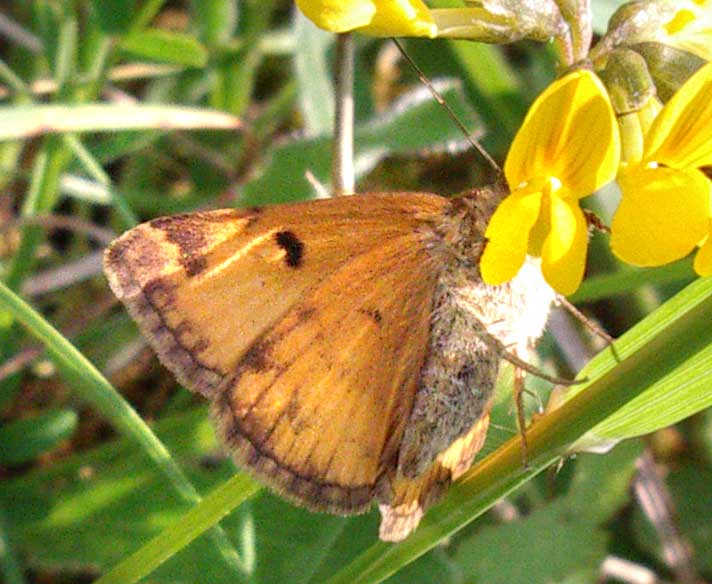 |
The
first of the year three or four Large Skippers
were spotted, but I did not recognise them until later. They occurred with
the Burnet Companion Moth (2+) which
is why I did not recognise them immediately.
Spotted
Orchids were begin to flower, but there did
not seem to many of them as last year quite yet.
Adur
Butterfly & Large Moth List 2005
Adur
Butterflies: First Dates
Flora
& Fauna (Extra Images)
 31
May 2005
31
May 2005
Passage
through at the top of The Drive revealed a Speckled
Wood Butterfly and a Red
Admiral Butterfly. Out of the shade into
the sunshine by the side of the A27,
there were three male Common Blue Butterflies
on what I think was mostly the Greater Bird's
Foot Trefoil by its greater height, with at
least two Kidney Vetch
in flower and flowering Bulbous Buttercups
amongst the Salad Burnet and
a single Spotted
Orchid. The hoverfly
Myathropa florea did its usual trick
of flying off a leaf when approached and then returning to the same leaf.
Adur
Butterfly & Large Moth List 2005
27
May 2005
A
freshly killed Roe Deer (with antlers)
was lying near the central reservation on the A27
as it goes through the Slonk Hill Cutting,
about midway on the same longitude as Buckingham Park.
 |
Lacewing and a Large Red Damselfly |
Very
little of note in the insect field: a handful each of Speckled
Wood Butterflies, Large
Red Damselflies, Andrena bees, Blue
Lacewings and the hoverfly
Leucozona lucorum
in
the shady area at the top of The Drive, Shoreham. Other species of hoverfly
were also present.
 |
 |
 |
|
Fumaria capreolata |
|
|
North Bank
There
were seven adult and intact Adonis Blue
Butterflies fluttering around the Horseshoe
Vetch. The Kidney
Vetch looked like flowering was imminent,
but not quite yet. A Small Heath Butterfly
settled on a Daisy
and I spotted and confirmed close-up my first male Common
Blue Butterfly of the year (I had already
seen a female). White Campion and Yellow Rattle
were
flower. Flora included the first appearance of a Spotted
Orchid.
An
adult Great Tit was
seen clearly amongst the Brown-tailed Moth
nests in a Hawthorn tree south-west of Buckingham Barn. The trees on the
road bank on the northern side opposite the Dovecote Bank look attractive
in autumn, but it looks like they are mostly Sycamores, Hawthorn and pines.
The vegetation in the open areas were rather rough clumps of grass with
a spread of Ground Ivy.
I disturbed a colourful male Pheasant
in this area.
Butterfly
& Moth Report
22
May 2005
Under
an overcast sky, the first female Adonis
Blue was recorded on the north bank of
the Slonk Hill Cutting with three
bright blue iridescent males, one which had
lost a wing. The female butterfly appeared to be an indeterminate variety
without the chocolate brown colour of the females. It is illustrated on
the left below.
 |
 |
The
first Common Blue Butterfly
of the year was also recorded on the south bank of Slonk Hill Cutting.
Surprisingly this was a female of the blue form, illustrated on the right
above. There was also a Large White Butterfly
on the northern bank and another one on the south and a Small
White Butterfly at the top of The Drive,
Shoreham
town.
Adur
Butterfly & Large Moth List 2005
Flora
& Fauna (Extra Images)
The
small spider Agalenatea
redii had woven a net amongst the
Salad
Burnet.
Adur
Spiders
 16
May 2005
16
May 2005
The
Kidney Vetch does not appear to be in flower yet on the south side and
there were no Small Blue Butterflies
on the overcast sky and breeze to be observed. The small blue butterflies
were all Holly Blues
and there was one Speckled Wood.
Also, a Red-tailed
Bumblebee and more than one Buff-tailed
Bumblebee.
NHM
Bumblebees ID
Adur
Bumblebees
11
May 2005
The
first occasional Kidney Vetch
is in flower on the northern bank at the bottom near the road. A Treble-bar
Moth, Aplocera,
was recorded. St. Mark's Flies
were very common on the southern side near the top of The Drive, Shoreham
town.
 |
 |
 |
24
April 2005
The
sun was just about out on passage over the Dovecote
Bank where there were three Small White
Butterflies and one Large
White Butterfly and one Holly
Blue showed,
with four Speckled Woods
at the top on the Drive, Shoreham.
On Dovecote Bank there were just a few clumps of Cowslips
and a few large Bulbous Buttercups
as well.
Adur
Butterfly List 2005
21
April 2005
 A
Large
Red Damselfly was seen over some brambles
at the top of The Drive, Shoreham. The red
was not very pronounced and this specimen was noted with a yellow horizontally
striped thorax when viewed from the side. A colourful
Long-tailed
Tit
attracted my attention with its call
from near the top of a tree.
A
Large
Red Damselfly was seen over some brambles
at the top of The Drive, Shoreham. The red
was not very pronounced and this specimen was noted with a yellow horizontally
striped thorax when viewed from the side. A colourful
Long-tailed
Tit
attracted my attention with its call
from near the top of a tree.
Adur
Damsels & Dragonflies
Freshwater
Life "Smart Group"
A handful
of Red-tailed
Bumblebees, and another handful of Common
Carder Bees
Bombus
pascuorum, favouring White Dead Nettle,
and at least one Buff-tailed Bumblebee
from
the wooded path (linear spinney) by Slonk Hill South with a half a dozen
Speckled
Wood Butterflies. When the sun came out
there was a Comma Butterfly
sparring with a Peacock Butterfly
in Hawthorn and the less wooded part of the path to the west, north of
Buckingham Park and Ravensbourne Avenue.
NHM
Bumblebees ID
Adur
Butterfly List 2005
Extra
Images (Buttercup +)
17
April 2005
The
Red-tailed Bumblebee,
Bombus
lapidarius, was definitely confirmed from the wooded path (linear
spinney) by Slonk Hill South.
Adur
Bumblebees
 15
April 2005
15
April 2005
On
the footpath at the top of The Drive, Shoreham,
a pair of Speckled Wood Butterflies
were the first this year. Later, I saw and recognised my first male Orange-tip
Butterfly
of 2005, ten yards in advance,
but despite this advanced warning, I failed to get a photograph as the
camera batteries ran out. This was on the
south-facing A27
road
embankment a the top (north) of the Dovecote Estate.
More
Images
10
April 2005
The
second butterfly of the day was a Red
Admiral Butterfly on the footpath
at the top of The Drive, Shoreham, and this was the first record of this
butterfly for April on these Nature Notes pages.
The Red Admiral
has been recorded in every month except
May.
Other
butterflies for the day included one a handful of both Peacock
Butterflies
(Mill Hill and the A27
road
embankment a the top [north] of the Dovecote Estate, Shoreham), Small
Tortoiseshell Butterflies (Mill Hill and
the A27
road
embankment), and one Holly Blue (top
of Chanctonbury Drive, near [SE of] Mill Hill).
There
was at least one Brown-tail,
Euproctis
chrysorrhea,
Moth nest on the footpath
at the top of The Drive, Shoreham. Honesty
was in flower and there was a handful of these plants in the shade.
Adur
Butterflies
Adur
Butterfly List 2005
Adur
Butterfly Flight Times
Adur
Butterflies: First Dates
National
Butterflies: First Dates
There
was what looked like an Andrena Mining
Bee (illustrated on the
Adur Bees web page) on
yellow flowers on the south-facing
A27
road embankment
north of the Dovecote Estate,
Shoreham.
Photographs
on the Adur Bees web page
On
the same bank, a 7-spot Ladybird,
Coccinella
septempunctata, was on the wing: after crawling around a bit, it flew
away.
3 April
2005
Just
one Small Tortoiseshell Butterfly was
seen over
the
A27 road embankment
north of the Dovecote Estate, Shoreham.
 |
 |
 |
This insect photographed
above on a Dandelion at the top of The Drive,
Shoreham looks familiar, but it does not seem to have been photographed
before.
Note the slender "waist"
though. It was not seen hovering. This is a Mining Bee? Andrena
haemorrhoa ?
Notes
on this Mining Bee
Earlier
Mining Bee (Link)
Adur
Bees web page
1 April
2005
I
disturbed a hen Pheasant
on the footpath at the top of The Drive, Shoreham.
It did not fly off immediately; it scuttled away until could find place
for a take-off.
27
March 2005
There
was nothing newsworthy along the bare southern path on a cool slightly
overcast day. Greater Periwinkle,
Daffodils,
Grape Hyacinth (garden escape) and Red
Dead Nettle (an ubiquitous weed)
were
noted in flower.
 |
 |
 |
|
|
|
|
16
March 2005
The
Rook
that flew over the path running adjacent to the A27
By-pass on the southern side was probably
from the small rookery in The Drive,
Shoreham. It flew in arc over the downs towards Mill
Hill.
Shoreham
Town & Gardens
Dovecote
Bank including the Mill Hill Cutting
Link to Slonk Hill Reports for 2004